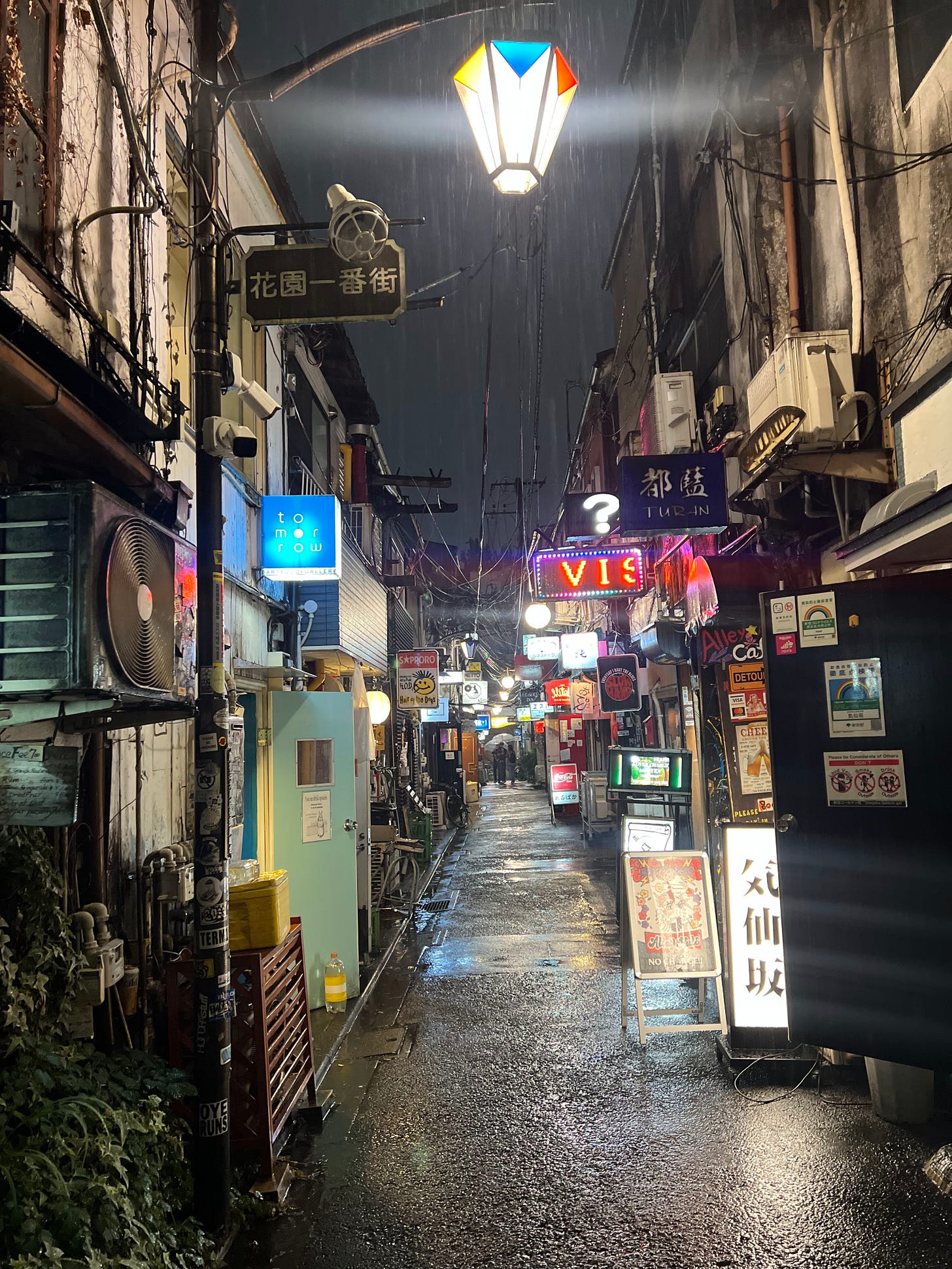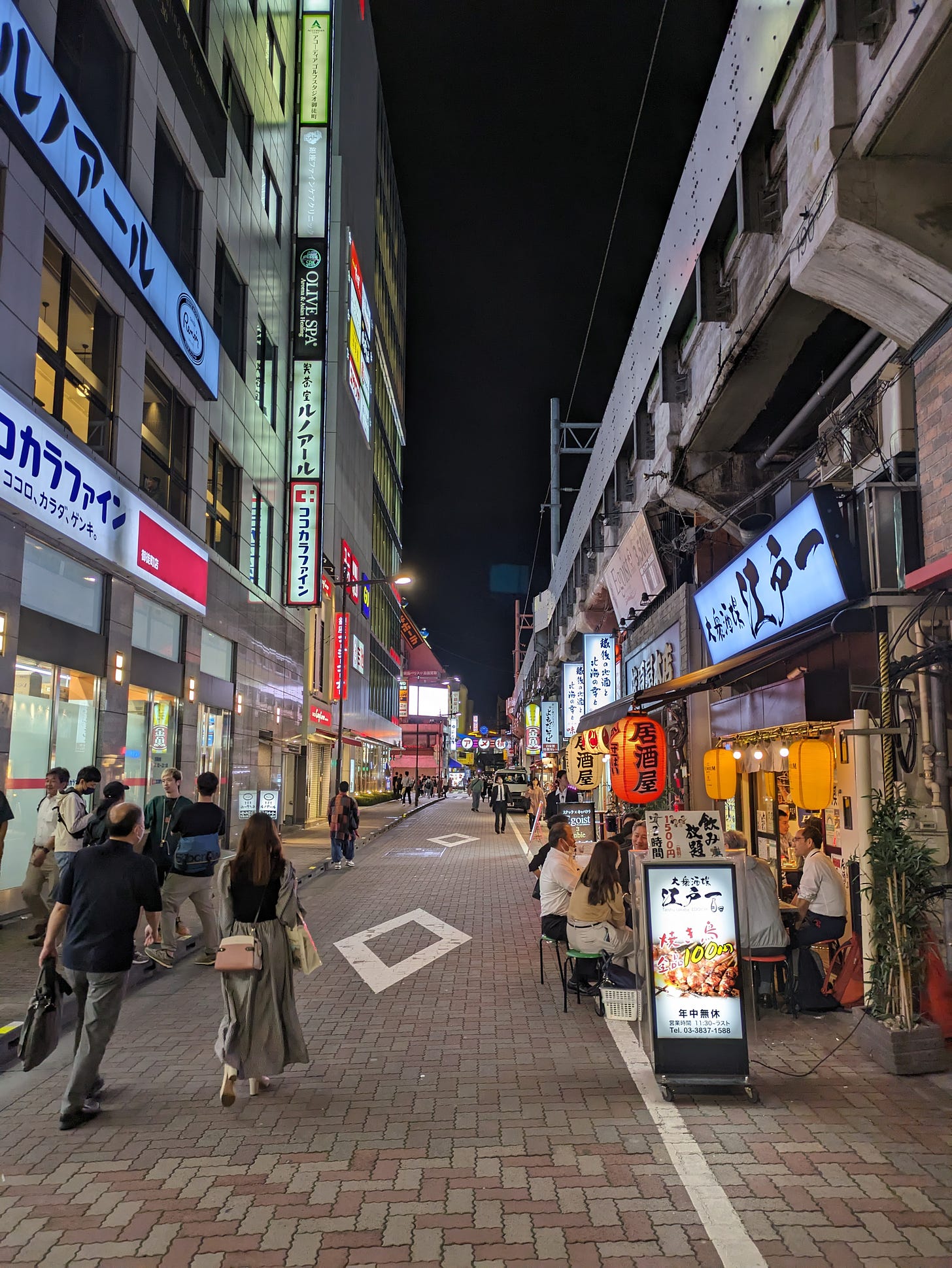Tokyo is the Honey Badger of Cities
A photo-essay on the ruthlessly practical urbanism of Japan's biggest city. (And what it can teach city builders)
This newsletter has lots of photos and is too big for email!
You’ll have to click the article’s title to read it in your browser.
I just returned from a few weeks in Tokyo, Osaka, and Kyoto, Japan and Taipei, Taiwan. I’m a shameless fanboy of the urbanism of East Asia. But Tokyo is the top.
Hope you enjoy the photos and words.
—
Tokyo Doesn’t Care
Hong Kong may have taller skyscrapers. Paris may look more postcard picturesque. But Tokyo’s joyful walkability and just-build-it spirit makes it one of the greatest cities on Earth.
I think of Tokyo as the honey badger of cities. Like the honey badger of nostalgic internet fame (audio NSFW), Tokyo is ferociously practical. On so many issues, Tokyo just doesn’t care. And this benign neglect makes the city beautiful and fun.
Part of Tokyo’s greatness is its incredible scale. With 14 million people in city limits, Tokyo could be the world’s 74th largest country. If you consider the entire metro, there’s actually 37 million people (!) in Tokyo. Yet Tokyo is the opposite of the dystopian megacity of cyberpunk imagination.
Tokyo is safe and clean. It’s walkable and bikeable. Things in Tokyo just… well... work.
As a frustrated American city-dweller, to visit Tokyo is to teleport to an alternate universe where cities are well-managed, building is legal, cars haven’t ruined everything, and even non-descript little sidestreets are pleasant and interesting:
What makes Tokyo so great? Much of it is what Tokyo doesn’t care about.
For example, you think streets need to be made from something fancy to be good? Tokyo disagrees. Tokyo serves up pavers, bricks, rough stones, and asphalt, often right next to each other.
Tokyo is neither an asphalt sea nor a cutesy throwback to a medieval village. Tokyo is meat and potatoes walkability. Most buildings sit at the sidewalk’s edge. Most streets are narrow, shared, and hostile to high speeds.
As ten minutes in Tokyo will show you, the core walkable pattern is more important than bricks or fancy bikepaths.


Are there bikes on Tokyo’s neighborhood streets? Plenty. Old people with canes? Safely trundling along. Strollers and wagons? I saw a lady hauling 5 munchkins in a giant Radio Flyer. Cars? Yep… driving 10 miles per hour.
And on its thousands of walkable streets, Tokyo offers a staggering variety of life. We’ve all heard of commerce on the first floor (still a radical idea for modern American cities).
But Tokyo says, “How about commerce in the basement or on the 10th floor?”

You want to open a coffee shop so small that no one can even sit inside? That’s cool with Tokyo.
Hang 6 neon signs? Tokyo says go.
Park an airstream in your front yard and sell garlic bread? Nice!
Pitch a tent in your alley to serve sake? As long as you don’t block the street or make people obviously unsafe, it’s all good with Tokyo.




Tokyo is also a master of monetization.
Tiny ledge on the edge of your property? “Why not put six vending machines along the sidewalk?”suggests Tokyo.

Tokyo’s creativity knows no limits.
Is a lot too small or a weird shape?
“Build an absurdly narrow apartment or office building!” suggests Tokyo.

You want to park your car on a robot elevator parking space? Paint your house pink and barf green with pseudo-Victorian gold embellishments?
“Just keep it inside your lot,” says Tokyo.
You think buildings are all about columns and cornices, Greek statues, and 5-story limits?
“Those are fine,” Tokyo says, “but so is almost anything else that won’t burn or fall down in an earthquake.”
Brutalist concrete? Go ahead.
Steel and glass? Also fine.
Pretty bricks like a London rowhouse? Cool with Tokyo.
Tokyo puts a 600-year-old temple next to 20-story luxury apartments next to some shack from the heyday of Hirohito. Is it the most aesthetic thing you’ve ever seen? No.
But it doesn’t bother Tokyo.

Tokyo’s tolerance for ugly-but-functional buildings makes plenty of room for the small.
All the cute romance of “mom and pop” record stores, cafés, and clothing boutiques actually exists in Tokyo. Why? Because an abundance of small spaces mean small entrepreneurs can afford space.
Is the building above ugly? Yes.
But it also holds 3 small businesses in the trendy Harajuku neighborhood. Are we sure that these entrepreneurs could operate if they were forced to consume more space or pay for nicer aesthetics? Thankfully, Tokyo doesn’t care.
And what about the big — all those skyscrapers that, in the words of Leon Krier, disrupt the “urban network”?
“Skyscrapers are fine!” says Tokyo, which then builds 3 levels of skywalks, 16 escalators, a 3-story underground movie theater, 8 floors of hotel rooms, and stretches an urban park over a highway just to prove how connected a skyscraper can be.
Tokyo connects skyscrapers from the air, the ground floor, and from underground:

Tokyo tends to shared spaces. That food truck in your front yard better not be an inch over the property line. But within reasonable rules and meticulous management of services, Tokyo says: let your freak flag fly.
Parking is a good example. You won’t find free street-side parking in Tokyo — leaving your car on a sidewalk is no way to treat a walkable street. But you also won’t find the massive mandated-by-law parking moats which define American cities.
As with so much else, Tokyo’s answer to parking is practical: don’t let people dump cars on the street, don’t subsidize cars with free parking, and otherwise let the market make space where its demanded.
Tokyo lets landowners run tiny parking lots and charge high prices (as they should for space in a valuable location).

Other entrepreneurs build small livery parking garages, an old-fashioned approach made modern through robotic lifts:

Hotels that must host the rental cars of tourists build incredible valet towers, often interesting buildings themselves, where rotating elevators hoist cars 15-20 stories.
But ah, I can hear some saying, just because people can build a lot of stuff doesn’t mean the city works. Think about all those chaotic cities in LatAm or Africa!
And you’d be wrong. Tokyo works.
Tokyo’s streets feel absurdly safe at all hours. They’re so safe that Japanese salarymen will drink themselves unconscious and sleep it off right on the sidewalk with their phone and wallet laying next to them:
Japanese children go about daily routines in Tokyo unattended — or, really, watched over by all the eyes on the street provided by mixed-use walkability. Children pay bus fares, cross the street, and walk to and from school in charming little herds.
Footage of these giggling free-range kids in sailor outfits (?) went viral on Netflix as Americans had their collective mind blown when they saw a city that actually works.
Tokyo brings its honey badger spirit to transit, too.
You think buses and trains should be about “beauty” or “democracy” or operate like a giant jobs program? Tokyo doesn’t get distracted by such indulgences. Tokyo knows that transit is about moving lots of people around quickly, reliably, and at a fair price.
Tokyo brings you a sparkling clean train every 4 minutes, for decades on end. The stations are clean. The pricing is rational. The public toilets have a sound machine and built-in bidet and seat warmer (I’m serious). And their transit data API actually works.

Or maybe you think capitalism has no place on public transit. Tokyo thinks that’s oh-so-impractical.
Tokyo plasters ads on every station surface, puts a vending machine on every platform, and builds self-storage facilities, driving ranges, hotels, and literal underground shopping malls around its stations so people can buy a Coach bag 100 feet from the train’s door.

In Japan, transit operators are held in high regard for their good service.
The photo below is from a fancy hotel in Osaka (not Tokyo… but the point still holds). Their rooftop restaurant — on the 34th floor — is co-branded as “by Osaka Metro.” Can you imagine “Burgers: Brought to you by the New York MTA”?

Like many Americans, I used to believe that public transit had to be a subsidized financial basket case, forever.
“Wrong,” says Tokyo as it IPOs its metro system. Tokyo is also the McKinsey of subways and sends an army of engineers around the world to fix trains in other, less-Tokyo cities.
But don’t all these trains destroy the city? What of monstrosities like the elevated train overpass? Surely this creates creepy dead zones that blight the urban fabric!
“Not on my watch” says Tokyo, “I’ll just turn that sketchy under-the-overpass shadow into a mixed-use neighborhood that brims with life all night.”
Behold Akihabara, a neighborhood that booms beneath a train overpass (on the right of these photos):
Tokyo hates wasted space. Businesses build right into the archways of the bridge, turning drab and sketchy concrete into beautiful, fun spaces.
Ah, I can hear some saying, just because people can build a lot of stuff and the city works well doesn’t mean it’s beautiful!
OK, sure. Tokyo doesn’t have the stone-and-ivy grace of a San Gimignano or a Venice. But is it fair to compare a booming megacity of 14 (or 37) million to these tiny live-in museums for tourists?
Besides, most of Tokyo feels like a modern spin on the gentle density of old Brooklyn, not Bladerunner. Walk the serpentine alleys of Shinjuku, stroll the manic neon of Kibukicho, take a coffee in Kamiyama, buy flowers in Jiyugaoka — each just one of hundreds of charming neighborhoods that most Americans would kill to live in were they part of Brooklyn or Boston.
Then remember that urbanism this good is normal, the default for millions of residents in Tokyo. Even for people who aren’t rich.
The Lesson of Tokyo
So what can Tokyo teach us?
The Startup Cities space is full of big visions and grand objectives about ecological regeneration, political reform, and architectural innovation. There’s nothing wrong with these ideas. A healthy market supports many visions.
But Tokyo is a counterweight to dreamier ideas of city management.
Honey Badger Tokyo has no time for grandiose schemes, fussy NIMBYs, architectural purists, or dreamy ideologies. It’s focused on the fundamentals: be walkable, be safe, and move people around quickly. Then it leaves a huge sphere of creativity to its residents. Tokyo sets the table and lets everybody eat.
Tokyo achieves a world-class city by ignoring trends and executing well on boring tablestakes urbanism like parking enforcement, light-touch zoning, and trains that come on time. It executes at incredible scale, breaks with convention through innovations like profitable transit, and provides a great life to millions of people.
And, to me, that makes Tokyo beautiful: the whirl of a city that actually works, where people are free to build.
—
Thanks for reading and don’t forget: startups should build cities!





















































Wow, amazing. So glad I discovered your work!
Wonderful, Zach!